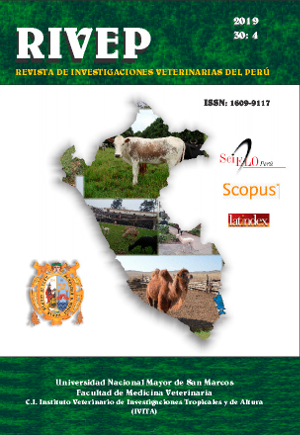Analysis of vicuña fibre production in semi-captivity and in the wild in Apurímac, Peru
DOI:
https://doi.org/10.15381/rivep.v30i4.17249Keywords:
chacu, performance, capture, shearing, fleeceAbstract
The aim of this study was to analyse the production of vicuña (Vicugna mensalis mensalis) fibre in semi-captivity and in the wild between 2008 and 2016 in the Apurímac region of Peru, as well as to determine the population of vicuñas captured and sheared and the effect of sex, age and management system in the fibre production. The production of vicuña fibre in the nine years of the study was 2 623 kg, annual average of 295.7 kg, yield of 152.76 g/vicuña and a range of variation of 54-426 g. Fibre production had an annual growth rate of 9.45% and a capture rate of 10.34%. Factorial analysis showed a significant difference (p<0.05) for the interactions of years, age, sex and simple effects.
Downloads
Downloads
Published
Issue
Section
License
Copyright (c) 2020 Miguel Angel Valenzuela Pinares, Víctor Alberto Ramos De la Riva, Ludwing Angel Cárdenas Villanueva, Sergio Danilo Pezo Carreón

This work is licensed under a Creative Commons Attribution-NonCommercial-ShareAlike 4.0 International License.
AUTHORS RETAIN THEIR RIGHTS:
a. Authors retain their trade mark rights and patent, and also on any process or procedure described in the article.
b. Authors retain their right to share, copy, distribute, perform and publicly communicate their article (eg, to place their article in an institutional repository or publish it in a book), with an acknowledgment of its initial publication in the Revista de Investigaciones Veterinarias del Perú (RIVEP).
c. Authors retain theirs right to make a subsequent publication of their work, to use the article or any part thereof (eg a compilation of his papers, lecture notes, thesis, or a book), always indicating the source of publication (the originator of the work, journal, volume, number and date).










